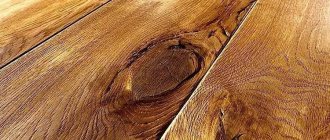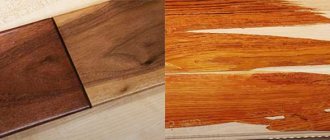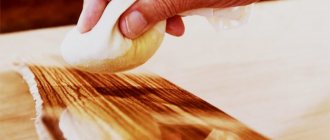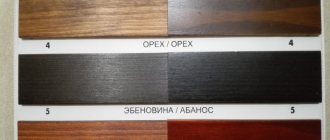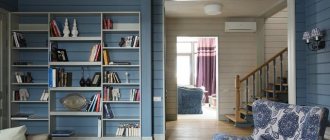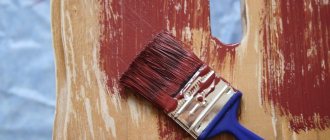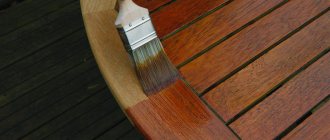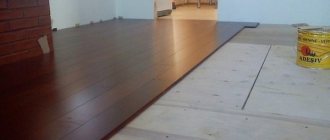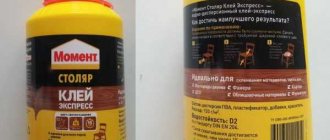Do you like the effect of artificially aged wood? Find out how and with what to paint brushed wood. The use of brushed wood in decorative finishing is a fashionable trend. Thanks to various brushing technologies, wood is artificially aged, as a result of which it acquires an antique look and a clearly defined structure.
Most often, hard types of wood are subjected to brushing - oak, walnut, Siberian larch, ash. These wood species have a fibrous structure and a beautiful textured pattern. The brushing procedure is carried out in stages. First, treat the surface with a stiff brush and sandpaper, then apply a suitable dye and finish with varnish.
All the subtleties of brushing and painting the material
Artificial aging of wood. A trend that is gaining popularity very quickly. Already this year, January has not yet ended, and we have completed 4 orders with brushing elements. I’ll tell you how we do it and why it’s better to turn to professionals rather than try to do it yourself.
You can artificially age wood only with the help of a professional tool. Even if you rent a tool, you will have to buy new brushes, and they are quite expensive. Well, the most banal thing. You need a big room to work.
I’ll tell you how we do it: We work with a professional brushing machine “Festul”. When brushing, we perform three passes with different brushes.
- Passing with a wire brush. This way we scrape out the soft wood fibers. Thereby setting the basis for highlighting the wood texture.
- Pass with a plastic brush 80. Smooth out all the sharp points and irregularities left by a rough pass with a metal brush.
- Passing with a nylon brush. This way we polish the material.
- We apply 320-grit Brite tape to the board by hand. Thanks to its spongy material, we are able to achieve complete removal of even the smallest lint. This is very important before painting if you decide to set the color and protect the brushed board.
And in the case of this order, in addition to brushing, we also carried out painting according to the Elite scheme. This is the application of a primer - an antiseptic and two layers of Teknos colored varnish, with all intermediate sanding.
Particular attention should be paid to interlayer sanding when painting brushed boards.
The surface of the board is not smooth and it is impossible to clean all the brushing grooves with a regular block.
When painting, after drying, the small pile stands up, becomes glassy and seems sharp and rough to the touch. Using the method of trial and experimentation, we began to polish the brushed board with sponge tape Brite, and not with an abrasive stone.
The order was completed perfectly. The customer also received a January discount of 20%, which will be valid until the end of the month.
PROMO We will paint façade panels for your home, lining and imitation timber for interior decoration in the workshop. A large selection of colors will allow you to find the best solution for you. Let's protect the tree from negative factors. Let's add aesthetics. They say about us: “Lesobaza paints furniture of furniture quality!” And it is true! See for yourself!
Painting production Lesobaza.rf
How to treat lining inside a house
In general, many people believe that it is better not to treat the lining indoors with anything. Maybe so, but not in every climate and room it will retain its original appearance for a long time. If the level of ventilation is insufficient, the wood may turn blue; if it is exposed to the sun, it becomes dark gray.
Blue discoloration can only be combated with biological means - chlorine or active oxygen, and then definitely impregnated with protective compounds, and maybe even painted. It’s a little easier with grayed wood: by removing the top layer by sanding you will again get a beautiful color, but without UV protection it won’t last long either. That’s why they decide to paint the lining inside the house or cottage.
One more point: not everyone likes wood in the interior. It's just that sometimes people get tired of looking at her. I just want a smooth, colored surface. This also happens, and often. In this case, look for opaque paint. Select characteristic effects as desired.
Opaque paints give an opaque film
The inside of the lining is painted with opaque paints also because wood in its natural color is not compatible with all styles. But sometimes you want to have a high-tech interior, for example, in a wooden house. In this case, paint with metal particles or mother-of-pearl (for example, Lignovit Platin) is suitable.
All compositions for protecting wood can be fairly roughly divided into six main groups:
- Protective compounds . Available for exterior and interior use. Compositions for external use additionally include ultraviolet protection, which prevents or slows down the process of photoaging of wood - discoloration to gray. So if you need impregnation for the lining on the balcony, and it faces south or east, you need a composition for external work. Just note that some of them turn the surface pink or green - this is the result of a chemical reaction. Read the description carefully, because the resulting color can only be painted over with opaque paints or a very dark tint.
The result of stains of different colors
The varnish can be glossy, matte or semi-matte, or it can give color - pigmented
Brushing with wood oils
This division is arbitrary: there are many mixed compounds that can be classified into at least two groups. So there are impregnations that can be tinted, and there are paints with protective properties. The difference is in the effectiveness of the protection. Impregnations primarily protect the wood, and imparting color is a secondary task. With paints it's the other way around. Their main task is to create a beautiful coating, and protection is a concomitant effect. If you immediately need good protection and high-quality coverage, take impregnation without tinting, and after drying, apply paint.
Another example of a mixed composition is oils with wax. These compositions combine the properties of both oils and wax, due to which the wood retains its appearance for a longer time.
The question of which group to give preference is up to everyone to decide for themselves. Different tools solve different problems, and it is important to choose the right properties that you need first.
Wood brushing
One of the methods of artificial aging of wood is brushing, the second name of the method is texturing. Using the brushing method, it is possible to give wooden objects a good aging effect. Brushing wood...
Brushing can age any wooden elements. From wooden floors to small decorative furniture details. After processing the wood by brushing, it acquires a seasoned, antique look, and its structure becomes clearer.
Any wood consists of soft and hard fibers. During the process of natural aging, soft fibers are destroyed, as a result of which the surface of the wood becomes embossed and textured.
To reproduce the same effect on fresh material, the wood brushing method is used.
For brushing, use a metal brush with stiff bristles. This is where the name of the method comes from. From the English word “brush”, which means “brush”.
Once you are fully familiar with the brushing process, you can easily do it yourself. This is a fairly simple method, but very effective.
What is the essence of brushing?
The natural aging process of wood occurs over a long period of time. The cut surface wears unevenly, the texture becomes uneven and somewhat wavy. Approximately this effect can be achieved if you treat a wooden product with special tools. Brushing wood when it is young removes the soft fibers, revealing the natural appeal of the wood's natural patterns.
Each product made of natural wood is unique and inimitable, thanks to the individual properties of each type of wood, moreover, of each trunk. However, not every wood species can be aged. Before brushing wood, you need to know about its susceptibility to this method. So, it is best to age pine, oak, larch, walnut, ash, wenge. But for beech, maple, birch, cherry, and alder, this finishing method is practically ineffective. The wood of these species does not have a pronounced texture. It has little noticeable transitions between layers of different densities, or even none at all.
Material and tool
Please note that not all types of wood can be brushed. Species such as maple, pear, cherry, and beech are not suitable. Choose larch, pine, oak, ash, walnut, those species that have an easily processed structure.
As for the tool, a hand brush with stiff metal bristles is suitable for a small area. And to process a large area, as a rule, they use a drill with the same metal attachment.
No. 2 Paint filling method
This method works best on unsanded wood with a slightly rough surface (such as a wooden fence). With its help, wood can be given a rustic look and an antique effect.
- Clean the wood with soapy water and a brush and leave to dry.
- If your paint is too rich, thin it with thinner.
- After this, pour some paint onto the wood surface, and then take a scraper and spread the paint over the wood.
On an unsanded, that is, not completely flat, wooden surface, the paint layer will not be the same everywhere. A little more paint will flow along the depressions and less on the bulges, that is, in some places the white color will be more saturated, and in others more transparent, which will create the effect of antiquity.
You can see the result of painting a wall using this method above.
Wood brushing process
A metal brush is moved along the fibers with slight, light pressure on the tool. The movements should be as if you are scraping wood until you get the look you want. It's important not to overdo it. Otherwise, instead of a beautiful, aged look of wood, you will get a damaged piece of wood.
Experienced craftsmen often use firing before brushing, since under the influence of fire, wood fibers are destroyed and can be easily removed from the surface.
But without proper experience, it is difficult to fire wood correctly. If you get distracted for a second, you can irrevocably damage the wood. Because under the influence of fire, not only the necessary fibers are destroyed, but also deeper ones. And this then affects the endurance of the tree and its service life.
Secrets of decorative wood staining: techniques and tricks
City dwellers want to preserve the natural color of wood as much as possible. For those for whom wood in the house is a boring everyday thing, paint the interior lining in some unusual color. Modern paintwork materials allow you to achieve different effects. For example, textured or brushed lining, but in two colors. This technique is often used in loft style interiors.
Brushed lining in two colors is an excellent choice for decorating walls
The trick is to apply two layers of different colors. The first layer is a dark color, the second is a light or brighter color. After playing with colors and the order of their application, you can create your own version. Watch the video - how to get lining brushed in two colors.
Painting in two colors may not be the same. You can make the recesses a darker color, and only slightly tint the face (front part) or do everything exactly the opposite. The result is a striped wall made of clapboard - the effect of a slatted wall.
Sanding after brushing
After using the brush, the wood takes on a textured, very beautiful appearance. But its texture becomes very rough. It needs to be smoothed before treating with stains and varnishes.
For grinding, after brushing, sandpaper of varying degrees of hardness is used. You need to sand along the grain of the wood, starting with coarse-grain sandpaper, then fine-grain sandpaper.
What paint do we use?
Traditionally, whitewashing was used as a cheap and easy way to protect wood (lime has antibacterial properties) and give it a neat appearance. Nowadays, when we recreate a whitewash, it is usually done with any water- or acrylic-based white paint for interior or exterior work (which is what we will do in the methods described here).
Water-based or acrylic paints without odor!! and can be used indoors
Finishing
After sanding, the wood can be coated with stain to give the desired shade. If you don’t need this, you can immediately coat the wood with varnish. The varnish is applied in several layers. The first layer is applied, allowed to dry, then sanded and cleaned of dust. The first, rough layer is necessary to raise the wood pile.
Next, apply a second layer of varnish and allow to dry completely. After complete drying, if necessary, add additional shine to the surface by polishing it.
How to paint lining like bleached oak
Often it is necessary to paint the wood white, but so that the veins are visible. They also say to create the effect of bleached oak. There are several ways:
- Use tinting with the appropriate name, which is also called stain. Different manufacturers have these. They usually have the names "frost", "bleached oak" or something like that. Application feature: do not pour too much composition. If you overfill it, the surface will begin to peel off over time. To achieve the desired degree of coloring, apply several very thin layers. After each, give it time to dry thoroughly.
Whitewashed lining looks great both on the walls and on the ceiling
It’s difficult to say which composition to choose - you need to try. It is advisable to paint the lining with several compositions and compare the results. The effect when using different products is slightly different, but it also greatly depends on the wood. The reviews are also very different - some whitened with tinting, others with oil. Soils are rarely used for these purposes, but mainly because not everyone knows their properties.
What is wood brushing
Among modern finishing materials, natural wood remains a relevant decorative element. Popular interior styles Provence, loft, colonial require that wooden furniture elements look as if our grandmothers used them. The paradox is that the older the tree looks, the more successful and noble the owner of such an office or living room appears.
#1: Painting with a rag
Many types of wood sold in hardware stores are already sanded and have a smooth surface (such as boards or sheets of plywood), but there are also unfinished boards.
This whitewashing method is suitable for both smooth and unsanded wood. It creates a neat and refreshing look, great for modern, farmhouse or Scandinavian style.
White paint makes the wood more refined, while leaving the opportunity to see the structure of the boards and their natural pattern.
How to do:
- First, dilute the white paint with a special solvent.
- After this, dip a rag into the resulting paint mixture and wipe it over the wooden surface, making an even layer.
Apply 1-2 more coats of paint if you want the color to look deeper white. Let the paint dry after each new coat.
Of course, you can use a brush, but it leaves strokes, while a rag makes the surface perfectly smooth.
What does the term wood brushing mean?
In the natural environment, wood is gradually subject to mechanical wear, the surface texture changes unevenly, loose layers are washed away, while dense layers remain. The result is an aesthetic picture created by nature and time. But try to find naturally aged wooden furniture now.
Artificially aged wood
Craftsmen resort to technologies for artificial aging of wooden surfaces. There is a word in the English language “brush” - brush, bristles. It gave its name to the term brushing as one of the methods of aging furniture, parquet, and interior items.
The essence of the technique is to enhance the texture of the natural grain of wood by combing out loose fibers and then treating them with special antiseptics.
Brushing wood is one of the aging technologies that emphasizes the natural beauty and noble texture of the material.
Burning
Firing wood is most often considered the first stage of brushing - just like with chemical etching, the softer areas are destroyed (burnt) first.
The beauty of simplicity. Photo from wickdpleasures.tumblr.com The wooden surface is burned with a blowtorch or gas torch, and then the charred parts are cleaned off, washed generously with water and coated with oil. The degree of firing and subsequent brushing depends on preference. You can also choose a blowtorch in our market; to do this, look at the products in the Blowtorches selection.
Wood that has gone through fire and water does not require additional tinting - the surface of the board takes on a noble dark shade. But if desired, charred wood can be additionally coated with colored stains. The combination of red and charcoal black looks especially impressive.
A house lined with burnt boards. Photo from skyhousedesigncentre.com
Firing can be an independent type of finishing. Now this direction is gaining popularity and is considered the Japanese technique Shou Sugi Ban (Yakisugi), although this method of woodworking is known in many countries. In Rus', burning wood was called smoking.
Fire-treated wood becomes less flammable and is practically not susceptible to rotting and damage by insects. Therefore, such boards are used for cladding facades and building fences. There is no need to regularly paint such a fence or facade - the burnt board does not change its qualities for a hundred years.
Fence made of burnt wood. Photo from oilobit.com
Naturally, the designers could not ignore such material. They began to use fire-treated objects in their interiors, and used boards using the Shou Sugi Ban technique of varying degrees of charring to decorate walls and ceilings. Oil coated surfaces do not get dirty.
Wall cladding using the Shou Sugi Ban technique. Photo from urbantimber.ca
Then the designers went even further and learned how to decorate pieces of furniture by firing. Things that look like they were rescued from a fire may not be to everyone's taste, but they look very stylish. See for yourself.
Try texturing familiar wood - perhaps you will discover a new material.
Source: 7dach.ru
How does the brushing procedure work?
The essence of the technique is quite simple: the surface is moistened with a chemical composition. Soft fibers absorb liquid. At the next stage, loose parts are selected with a stiff brush. Solid fibers remain, which form a unique pattern. To enhance the effect, the surface is additionally treated with dye.
The result is an interesting stylized texture, with a slight touch of aristocracy and charm.
No. 3 Painting method using a candle
Worn white paint, through which in some places you can see the wood itself in its natural color, is wonderful when restoring antique furniture or creating new ones, but in the same style.
In the photo below you can see an example of such painting of wood with wonderful designer pens laid out on it.
Instructions:
- Take a clean wooden board (no matter sanded or not) and a candle. Rub the candles onto the surface of the wood in several places. You need to press quite hard on the candle so that a clear trace of wax or paraffin remains on the wood.
- After this, paint the wood with white paint and let it dry completely.
- Wipe the dry painted surface with a rag, applying some pressure. In those places where there was a trace of a candle, the paint will come off the surface.
Below is an example of a white wood floor painted using this method. It is worth noting that when using this, it is better to apply a layer of protective varnish on top of the paint for more durable use.
What tools and materials are needed for the job?
If you decide to age a buffet, chair or mantel yourself, then first prepare a set of tools. To use the brushing technique you will need:
- sandpaper of different grits (coarse-grained is suitable for roughing, fine-grained for finishing polishing of surfaces);
- two or three metal brushes of varying degrees of hardness;
- stain (to give individual elements additional decorativeness);
- paints for tinting;
- matte or glossy varnish for finishing.
Varnish coating
For large volumes of work, a stripping milling machine is used, which automates most of the aging processes. Replaceable attachments allow you to perform grinding, polishing, and brushing in stages.
Using a power tool speeds up the brushing process
When made by hand, the product looks more aesthetically pleasing, it looks like a piece product.
Brushing equipment
To an inexperienced person, brushing wood may seem like a complicated and inaccessible process. In reality this is not the case at all. You need to have a room for creativity, that is, a workshop, the necessary equipment and a little effort. To work you need to prepare:
- sandpaper in a set, with different degrees of grain;
- a set of special brushes for brushing wood;
- stain, preferably several shades to enhance the color scheme;
- Transparent wood varnish for final finishing of the product.
Some craftsmen prefer mechanized labor to manual labor. Therefore, instead of ordinary brushes, an electric tool for brushing wood, equipped with a set of brushes, is used. You can also use a home drill with a speed controller with special attachments. Each of the brushes has its own purpose:
- a steel wire brush is needed for the main process - brushing wood with your own hands;
- a brush with synthetic fiber bristles performs the first sanding;
- A soft brush is necessary for final polishing of the surface.
It should be noted that it makes sense to purchase special equipment (machines or machines) to perform a large volume of work. If we are talking about isolated cases, then there is no reason to spend money on purchasing an expensive tool for brushing wood, and do the work manually.
How to age wood yourself
Brushing wood with your own hands is done in several stages. Typically the sequence of actions is as follows:
- The workpiece is slightly moistened with water; in the further process of work there will be less dust.
- Using a stiff metal brush, begin the initial surface treatment. Make sure that the bristles scrape out only the soft layers without damaging the dense ones. They work in the direction of the fibers.
- To make it more decorative, go over some areas with a chisel and select recesses of arbitrary shape. After rough sanding with softer brushes, they are shaped into the old cracks that have gradually formed in the wood.
- Next, the parts are sanded with coarse sandpaper. Having removed everything unnecessary, they evaluate how well the structuring was carried out. Make sure that the treated surface has a natural appearance and that traces of treatment are not noticeable. If necessary, additional cleaning is carried out.
- Final polishing with fine-grained sandpaper.
- Depending on the design, parts are painted, tinted, patinated or gilded.
When tinted with ordinary stain, an interesting two-color texture is obtained. The composition is applied in a thick layer, the excess is quickly removed. Areas with soft fibers have time to dye, but hard layers do not have time to absorb the pigment and remain light.
7. After drying, the finishing stage begins: the workpiece is varnished.
This easy-to-use technique allows you to transform an ordinary interior into an elite, expensive, stylish one.
Chalet style interior
A mantelpiece, ceiling beams, headboards, and a sideboard made of aged wood will emphasize the taste of the owners.
How to properly paint the inside of the lining: technology
To paint lining in “dry” rooms inside the house, you can use any type of paint. Here you simply decide on the requirements for the decorative appearance of the surface. If the lining is dry, it can not be impregnated with protective compounds, or you can choose paint/varnish/wax with appropriate additives. You can paint it only on one side, leaving the back side untreated.
Paint each panel of the lining separately
If the lining will be used in damp or unheated rooms, on a balcony, it must first be thoroughly impregnated with protective compounds on all sides, maybe twice. Only after the impregnation has dried can it be painted, varnished, or, in general, given decorative properties. Another point: when installing the lining on a wall or ceiling, it has to be cut into pieces. Places of cuts in damp rooms must also be coated with the composition. It is not necessary to wait until it dries, but it is necessary to process it.
There is one very important nuance that many amateur decorators overlook. If you want to get a professional-level painting of the lining, you need to process each board separately: sand, paint, dry, and only then assemble the surface from the already painted lining. That is, mount already fully processed boards on the wall or ceiling. Only with this approach will the surface of the lining have the same color from any point.
It’s difficult to paint the entire surface of a clapboard wall well
If you paint an already assembled surface, unpainted areas remain in the grooves and recesses, making it difficult to sand large areas. You definitely won't get a perfectly flat surface. The quality of finishing in this option is not above average. It is permissible to paint a finished surface if you are renewing the paint job. This must be done at different intervals, depending on the operating conditions and the properties of the paintwork material.
Correctly, the painting technology looks like this.
- The lining is checked and sorted. All bent, bent or cracked boards are rejected. They can be used to test color, select color, number of layers, practice technique and painting sequence.
- Boards that have been sorted are sanded until completely smooth. It is most effective to work with a sanding machine, but you can also use a block with sandpaper attached to the surface. Sandpaper grit - 250-280. When grinding, circular movements pass through the face, tenon and groove. The back part of the lining can be left without treatment.

